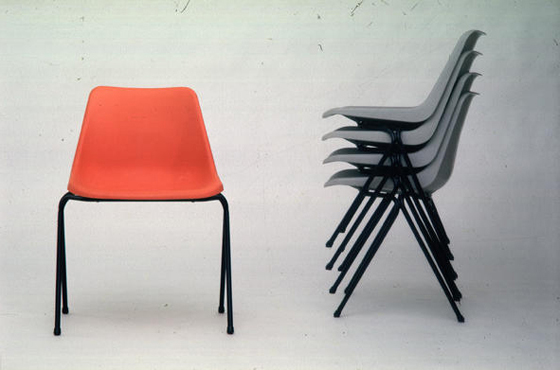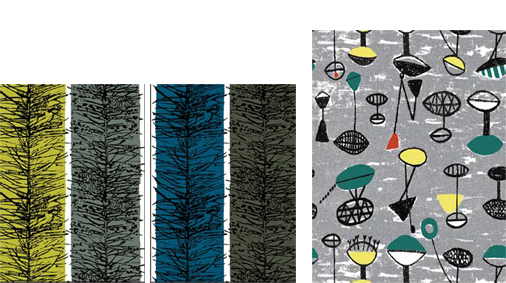Lucienne Day: 1917–2010
Text by Simon Keane-Cowell
Zürich, Switzerland
11.02.10
We bid a fond farewell to one of the greats of British post-war design history.
The sad news of revered British designer Lucienne Day's death in January, at the age of 93, brings to an end the joint-reign of one England's most renowned designer couples. Robin and Lucienne Day, through their pioneering work in furniture and textile design, as well as in the field of graphics, offered post-war Britain an optimistic, decidedly modern vision of itself, in contrast to the austerity of the time, through their contribution to a material culture that was confident and progressive.
Robin Day, who is now 95, is perhaps best known for his 'Polypropylene Chair' (1963), one of the best-selling pieces of furniture worldwide; remarkably, he continues to work and has received commissions in the past decade from leading British brands SCP and twentytwentyone, as well as from Italian manufacturer Magis.
'Calyx' textile design by Lucienne Day for Heal's, 1951
Lucienne Day will be remembered most readily for her striking textile designs of the late 1940s and 1950s, which cleverly combined the abstraction identifiable in international contemporary art of the time with the British tradition for natural motifs in pattern design, dating back to William Morris and the Arts and Crafts movement of the 19th century. The echoes in her work of the visual language of, among others, Kandinksy, Calder and Miró have often been commented upon.
'Polypropylene Chair' by Robin Day for Hille, 1963
'Calyx', designed for London design shop Heal's, was the iconic fabric that was truly to establish Lucienne's name. Created in 1951, it was launched at the Festival of Britain, a design-historical event with which both of the Days will forever be connected. (Robin Day played a significant role in shaping the physical landscape of the festival site on London's newly created South Bank, designing dining and lounge chairs for the Royal Festival Hall and seating for its auditorium, as well as free-standing directional signage for use across the festival grounds.) The fabric, whose cupped forms represented flowers in abstracted form and whose bold colours resonated so strongly with the primary-coloured theme of the South Bank, captured the public imagination. Design writer Lesley Jackson describes the design as having 'electrified the whole of the British textile industry, as well as sending shock waves abroad'. The Gold Medal 'Calyx' won at the 1951 Milan Triennale testifies to the latter.
'Larch' (1961) and 'Flotilla' (1952) textile designs by Lucienne Day for Heal's
In addition to her 20-year partnership with Heal's (which resulted in 70 textile designs), Lucienne worked in the 1950s and 60s with, among others, German ceramics manufacturer Rosenthal, for whom she created a number of tableware patterns, and designed wallpapers for Rasch, whose reputation had been founded decades earlier on producing Bauhaus designs. At home in England, Lucienne was later to become consultant to the John Lewis Partnership department stores.
Room setting at the Milan Triennale, 1951; Robin Day 'Lounge Chairs' (originally designed for the Royal Festival Hall, London) in foreground and Lucienne Day 'Calyx' fabric in background

Room setting at the Milan Triennale, 1951; Robin Day 'Lounge Chairs' (originally designed for the Royal Festival Hall, London) in foreground and Lucienne Day 'Calyx' fabric in background
×Lucienne Day was by all accounts (and like her husband, Robin) a generous person, so it is apt that her seminal textile designs from the post-war period, a number of them still in production, should continue to give pleasure to so many of us, looking just as compelling as they did 60 years ago. For this, Lucienne, we thank you.






